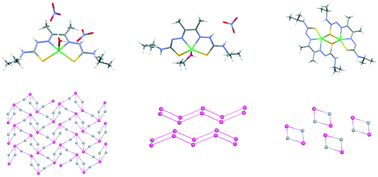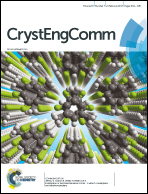Structural diversity and supramolecular architectures of Zn(ii), Cu(ii) and Ni(ii) complexes by selective control of the degree of deprotonation of diacetyl bis(4-isopropyl-3-thiosemicarbazone)†
Abstract
The reactivity of the new potentially tetradentate ligand diacetyl bis(4-isopropyl-3-thiosemicarbazone) (H2L) with zinc(II), copper(II) and nickel(II) nitrates using different amounts of lithium hydroxide was studied. The results obtained show that with zinc(II), selective ligand deprotonation was completely achieved and complexes [Zn(H2L)(OH2)](NO3)2 (1), [Zn(HL)(EtOH)]NO3 (2) and [ZnL]2 (3) were synthesized, where the ligand acts as a neutral, singly or doubly deprotonated donor, respectively. In contrast, in the case of copper(II), only complexes [Cu(HL)]NO3 (4) and [CuL] (5) were isolated, whereas with nickel(II) the double deprotonation of the ligand took place even in the absence of a base, to yield complex [NiL] (6). The structural preferences of the metals also influence the structure of the complexes; whereas copper(II) and nickel(II) are in a square-planar arrangement, zinc(II) prefers a square-base pyramid geometry. In all the complexes containing a NO3− ion, the ion is not coordinated to the metal and acts as a counter-ion. The different degrees of deprotonation of the ligand, together with the presence or the absence of nitrate and solvent molecules bonded to the metal, make the existence of different supramolecular architectures based on different hydrogen bond arrays possible. The topological analysis shows the formation of 2D (1) and 1D (3 and 5) networks, tetranuclear aggregates (2 and 5·DMF) and dimers (6·DMF), which are linked by other weak interactions to give 2D or 3D nets.



 Please wait while we load your content...
Please wait while we load your content...